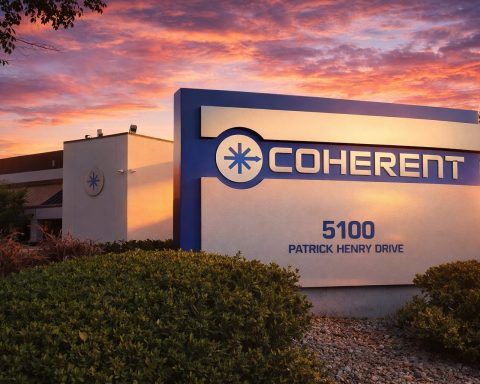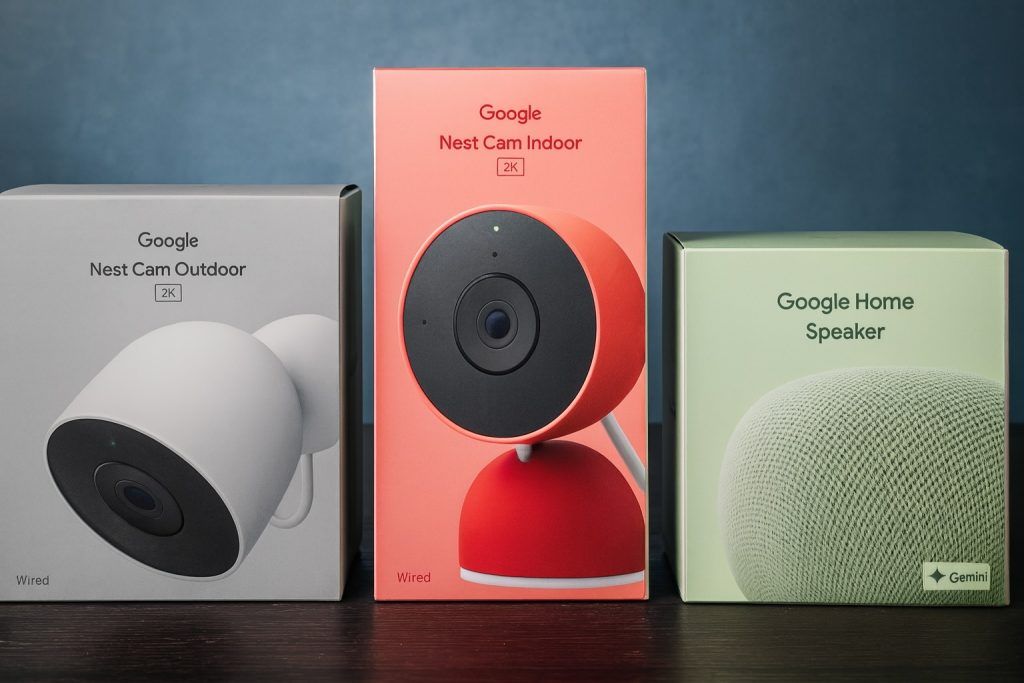- Quantum Stocks Skyrocket in 2025: Pure-play quantum computing companies like IonQ, D-Wave, and Rigetti have seen their share prices multiply this year – IonQ is up several hundred percent, Rigetti over 160%, and D-Wave nearly 280% year-to-date [1] [2] – reflecting surging investor optimism.
- Tech Titans Go Quantum: Industry giants IBM, Alphabet (Google), Microsoft, Intel, and Amazon are investing heavily in quantum R&D and making breakthroughs, from IBM’s 433+ qubit processors to Microsoft’s novel “Majorana 1” topological chip unveiled in 2025 [3].
- Game-Changing Innovations: 2025 brought milestone advances – IonQ’s acquisitions (e.g. Oxford Ionics) target 800 logical qubits by 2027 [4], D-Wave’s new 4,400-qubit Advantage2 annealer delivers 20× connectivity for real-world optimization [5], and Rigetti’s latest chip hit 99.5% gate fidelity on a 36-qubit system [6].
- Big Deals and Partnerships: Governments and Fortune 500s are engaging: Rigetti won a U.S. Air Force contract for quantum networking [7], D-Wave’s tech slashed police response times 50% in a UK pilot [8], and IonQ inked deals from Japan’s AIST to South Korea’s KISTI to build quantum centers [9].
- Strong Funding & Forecasts: Global public funding for quantum tech is rising (34% of all 2024 funding, ~$680M [10]), and experts forecast the sector’s revenue to surge from ~$4B in 2024 to $72B by 2035 [11] – even $1+ trillion in economic value by then. Analysts have issued bullish calls (Needham’s IonQ $80 target [12]) but caution that profitability for pure-plays is still years away [13] [14].
Quantum Computing: The Next Frontier in Tech Investing
Quantum computing concept illustration. 2025 has seen quantum technology leap from labs toward commercial viability, fueling a wave of investor interest and stock gains.
After the AI frenzy, quantum computing is emerging as the next big tech investment trend [15]. Quantum computers leverage bizarre physics to solve problems vastly faster than classical machines, promising breakthroughs in drug discovery, finance, AI, logistics, and cybersecurity. In 2025, this once-experimental field is rapidly moving from concept to reality – and Wall Street has taken notice. Many companies agree that around 2030 will be a turning point when quantum systems achieve useful scale [16]. But investors aren’t waiting; quantum stocks have soared in 2025, anticipating the technology’s transformative potential.
Several pure-play quantum computing firms that went public via SPAC in recent years have skyrocketed. Over the past six months, shares of IonQ jumped 135%, Rigetti 105%, and D-Wave over 200%, vastly outperforming the S&P 500 [17]. Much of this surge came in Q3 2025, as a string of technical and commercial milestones signaled that quantum computing is edging closer to practical use. At the same time, tech giants like IBM, Alphabet (Google), Microsoft, and Intel – which view quantum as strategic to their future – have accelerated their R&D efforts and notched record achievements of their own. Major governments worldwide (USA, EU, China, and Japan) are pouring funding into quantum research programs, recognizing it as a critical technology race. This confluence of scientific progress, corporate commitment, and public investment has made quantum computing a compelling – if speculative – area for investors seeking the “next big thing.”
However, it’s still early innings. Today’s quantum computers remain in prototype stage, generating minimal revenue, and the path to large-scale, fault-tolerant quantum machines (needed for broad commercial adoption) will likely take the rest of this decade. Investing in this space requires patience and risk tolerance, as many pure-plays are unprofitable and may never reach mass-market success. That said, the upside could be enormous. McKinsey projects the quantum computing market to grow at ~35% CAGR, potentially reaching tens of billions by 2030 [18] [19]. By 2035, quantum tech could drive over $1 trillion in economic value and hundreds of thousands of new jobs [20]. In the nearer term, breakthroughs expected by 2025–2027 (such as achieving quantum advantage on useful problems, or demonstrating early error-corrected qubits) could dramatically reprice the leaders in this industry.
In this report, we’ll examine the top pure-play quantum computing companies and the leading quantum players within Big Tech, highlight their recent developments (especially in Q3–Q4 2025), and survey expert commentary and analyst outlooks. We’ll also discuss the broader ecosystem – including companies providing the “picks and shovels” like quantum hardware components and cloud services – that support this quantum boom. To start, the tables below offer a high-level comparison of key quantum computing stocks:
Pure-Play Quantum Computing Stocks (Specialized Startups)
| Company & Ticker | Market Cap (Oct 2025) | Quantum Focus | Recent Developments (2025) | Analyst Sentiment | YTD Stock Perf. |
|---|---|---|---|---|---|
| IonQ (NYSE: IONQ) | ~$16.5 B [21] | Trapped-ion quantum computers; quantum networking | Acquired startup Oxford Ionics (ion-trap chips) in $1B deal; formed IonQ Federal unit to serve U.S. government [22]; new partnerships in Japan (AIST) and Korea (KISTI) [23]; demonstrated 20× speedup in quantum drug discovery with AstraZeneca & AWS [24]. Raised 2025 revenue guidance to $82–100 M [25]. | Buy – Needham raised target to $80 [26]; Zacks Rank Hold (high innovation but losses) [27]. | ↑ 600%+ (approx.) |
| D-Wave Quantum (NYSE: QBTS) | ~$6.1 B [28] | Quantum annealing systems (optimization) | Launched sixth-gen Advantage2 system (4,400+ qubits) for general availability [29] [30]; 50% faster police dispatch demo with North Wales Police [31]; hybrid quantum solver used by Ford (85% reduction in scheduling time) [32]. Completed $400 M equity raise (Q2), boosting cash to $819 M [33] for R&D (e.g. cryogenic packaging with NASA JPL; roadmap to 100K qubits) [34]. | Moderate Buy – Consensus expects growing adoption; investors bullish on real-world use cases. (Shares up despite no profits) [35] [36]. | ↑ 280% [37] |
| Rigetti Computing (Nasdaq: RGTI) | ~$11–13 B [38] [39] | Superconducting quantum processors | Achieved 99.5% gate fidelity on latest 36-qubit chip (July) [40]; aiming to debut 100+ qubit multi-chip “Novera” system by late 2025 [41]. Won $5.8 M USAF contract (Sep) to develop quantum networking with superconducting qubits [42]. Received purchase orders (~$5.7 M) for two Novera quantum computers (delivery in 2026) [43] – first commercial system sales. Operates its own fab (“Fab-1”) to manufacture chips [44]. | Strong Buy – 5–7 analysts cover Rigetti (avg. PT ~$20) [45] but note execution risks. Stock surged on news (market cap jumped $1.5 B on a $5.7 M order) [46], reflecting high speculative optimism. | ↑ 162% [47] |
| Quantum Computing Inc. (Nasdaq: QUBT) | ~$0.6–0.8 B (est.) | Photonic quantum tech; quantum sensing & software | Opened new quantum photonic chip foundry in Arizona (thin-film lithium-niobate) to scale production [48]. Secured initial product sales: a quantum LiDAR/vibrometer to TU Delft, an entangled photon source to a S. Korean institute, and a photonic AI computing module (“Entropica/Emu”) to an auto manufacturer [49]. Made first commercial quantum cybersecurity sale to a U.S. bank [50]. Won small NASA contract (with Langley) for quantum sensing [51] and a NIST R&D contract [52]. Ended Q2 with $349 M cash after big capital raises [53] (plans to hire and pursue acquisitions). | Buy – Recently added to Russell 2000 index [54]; a few analysts have Buy ratings (seen as long-term speculative play). Zacks Rank #3 Hold given minimal revenue and high cash burn [55]. | ↑ >100% (volatile) |
Major Tech Players Investing in Quantum R&D
| Company (Ticker) | Quantum Ambitions & Focus | Recent Quantum Milestones (2025) | Analyst/Expert View | Stock 2025 YTD |
|---|---|---|---|---|
| IBM (NYSE: IBM) | Superconducting quantum computers; IBM Quantum Network; Quantum-safe cryptography | Operating 20+ cloud-accessible quantum systems (5–433 qubits) for enterprise and research. In June 2025, IBM announced construction of the world’s first large-scale, fault-tolerant quantum computer at its NY data center [56] – part of its roadmap to a 100+ logical qubit system by 2029 [57] [58] (“IBM Starling”). Collaborating with Japan’s AIST to develop a 10,000-qubit system by 2029 [59]. Continued hardware advances: e.g. testing the modular 133-qubit Heron processors and next-gen “Loon” chip for improved connectivity [60] [61]. | Seen as a quantum leader: IBM’s early lead and full-stack approach (hardware + Qiskit software + cloud) make it a top player [62]. Analysts view quantum as a longer-term growth driver for IBM (complementing its AI and cloud businesses). IBM stock is stable, with quantum progress reinforcing its tech leadership image. | +10% (est.) |
| Alphabet (Google) (Nasdaq: GOOGL) | Google Quantum AI lab – superconducting qubits; quantum ML; quantum supremacy demos | Achieved quantum supremacy in 2019 (Sycamore 53-qubit). In 2025, Google unveiled its new “Willow” quantum chip, demonstrating improved quantum error correction that paves the way to scalable, useful quantum computers [63]. Google’s team realized exotic topological phases on its quantum processor (advancing physics research) [64]. Pushing toward 1 million physical qubits via a six-milestone roadmap [65]. Offers quantum services through its Cloud (e.g. Cirq software framework), though it hasn’t commercialized its own hardware service yet. | High R&D commitment – Alphabet invests billions with no near-term revenue expected from quantum. Analysts consider Google’s quantum unit as “moonshot” research: potentially revolutionary, but not priced into the stock yet. If/when breakthroughs come (e.g. fault-tolerant qubits), Alphabet’s dominance in cloud and AI could extend into quantum. For now, its core ad & cloud earnings drive the stock (up modestly). | +30% (est.) |
| Microsoft (Nasdaq: MSFT) | Topological qubits research; Azure Quantum cloud platform (hardware & software ecosystem) | February 2025: Microsoft revealed “Majorana 1” – the world’s first quantum processor using topological qubits, a novel approach promising far greater stability [66]. The 8-qubit Majorana 1 chip (using exotic Majorana zero modes) is designed to scale to 1 million qubits on one chip [67]. Microsoft’s researchers demonstrated a hardware-protected logical qubit in Nature, a milestone in error correction [68]. Under DARPA’s US2QC program, Microsoft is racing to build a fault-tolerant prototype within a few years [69]. Meanwhile, Azure Quantum has become a leading cloud service for quantum, hosting hardware from IonQ, D-Wave, Quantinuum, etc., and launching tools like Azure Quantum Elements for integrating quantum into chemistry and materials science workflows. | Strong Buy – Microsoft’s quantum efforts are often overlooked next to its AI and cloud dominance, but experts say its “quantum bet” could pay off big in the 2030s. The Majorana approach is high-risk/high-reward – if successful, MSFT could leap ahead with scalable quantum hardware. Analysts remain bullish on MSFT overall (quantum is a tiny portion of its $2T market cap), seeing its diversified R&D as evidence of visionary leadership. | +35% (est.) |
| Intel (Nasdaq: INTC) | Silicon spin qubits on semiconductors; quantum control chips (cryogenic CMOS) | Focused on leveraging its semiconductor fabs to mass-produce quantum chips. Intel’s 12-qubit Tunnel Falls silicon-spin chip (launched 2023) was made available to researchers [70], and Intel promised a more advanced spin qubit chip by 2024 (with better uniformity and fidelity achieved per a Nature paper) [71]. In Feb 2025, Intel signed an MoU with Japan’s AIST to co-develop a next-gen quantum computer, providing cutting-edge chips for a system to be shared with researchers [72]. Intel is also a key player in Europe’s ARCTIC project to build a supply chain for cryogenic quantum tech (cryogenic control electronics, interconnects) [73]. Continues to refine its “Horse Ridge” cryo-controller and packaging techniques to manage large qubit arrays at millikelvin temperatures. | Mixed – Intel’s foray into quantum is strategic (potentially securing a role as the manufacturer for future quantum hardware), but progress has been slower versus startups. Some analysts are skeptical given Intel’s core business struggles; others note that success in quantum could rejuvenate Intel’s innovation image. With the stock underperforming recently, any clear quantum breakthroughs or big partnerships (e.g. supplying chips to national labs) could improve sentiment. For now, Wall Street values Intel more on its PC/server turnaround than on quantum potential. | +5% (est.) |
| Amazon (Nasdaq: AMZN) | AWS Braket quantum cloud service; investing in multiple quantum hardware modalities (superconducting, ion traps, neutral atoms) | Amazon’s strategy is to be the “Switzerland” of quantum cloud services. AWS Braket offers on-demand access to various quantum processors (D-Wave, IonQ, Rigetti, QuEra, Oxford Quantum Circuits) via its cloud platform. Amazon also conducts in-house R&D: its AWS Center for Quantum Computing (with Caltech) is developing superconducting qubit hardware, and the AWS Center for Quantum Networking (launched 2022) is exploring quantum communication. In 2025, Amazon expanded Braket with more advanced systems (e.g. hosting IonQ Forte and Quantinuum hardware) and introduced improved simulators for hybrid quantum-classical algorithms. It’s also partnering with universities on quantum education and providing cloud credits to incubate quantum startups on AWS. | Positive long-term – Amazon’s cloud analysts view quantum as a natural extension of AWS’s “compute-as-a-service” offerings. While not expected to contribute revenue for several years, Amazon is ensuring it won’t be left behind. Its broad approach – supporting all leading technologies on Braket – positions it to benefit from quantum progress regardless of who wins the hardware race. Analysts remain bullish on AMZN (thanks to e-commerce and AI cloud growth), and see its quantum program as a small but important moonshot that reinforces AWS’s innovation ecosystem. | +20% (est.) |
Enabling Technologies & Specialized Suppliers: In addition to the above, a network of suppliers and partners stands to gain from the quantum boom. For example, Keysight Technologies (NYSE: KEYS), a test & measurement leader, provides quantum control electronics and diagnostic tools (it even acquired startups in quantum error analysis). Oxford Instruments (LSE: OXIG) is a key provider of ultra-low-temperature dilution refrigerators and cryostats – essential for superconducting and spin qubit systems – used by labs worldwide. Chipmakers like TSMC and equipment firms like Applied Materials are beginning to adapt their processes for quantum chip fabrication. Even NVIDIA (which currently supplies GPUs for quantum simulations and hybrid workloads) is indirectly part of the story – in fact, Microsoft and Alphabet currently spend heavily on NVIDIA hardware for classical AI computing; viable quantum hardware in-house could eventually reduce those costs [74]. As quantum moves toward scale, these “picks and shovels” players could see increased demand. However, many are large diversified firms where quantum is only a small component of their business today.
Recent News Driving the Quantum Sector (Q3–Q4 2025)
The latter half of 2025 has delivered a flurry of news highlighting both progress and challenges in quantum computing:
- IonQ’s Bold Moves: IonQ, the first pure-play quantum company to go public (in 2021), has dramatically expanded its capabilities this year. It is acquiring multiple companies to accelerate its roadmap – notably UK-based Oxford Ionics, whose chip-integrated ion traps could help IonQ scale to 800 logical qubits by 2027 and 80,000 by 2030 [75]. It also bought smaller firms (like Lightsynq and Capella Space) to integrate photonic interconnects and satellite-based quantum links [76]. These moves make IonQ the only quantum hardware company explicitly integrating networking (quantum repeaters, QKD via its ID Quantique unit) into its architecture [77]. On the partnerships front, IonQ signed deals in Japan (AIST’s G-QuAT lab) and South Korea (KISTI) to deploy its systems in national quantum hubs [78]. In the U.S., it secured a $22 M contract with EPB (a Tennessee utility) to build America’s first commercial quantum network [79], and was selected by DARPA to help develop industry standards [80]. IonQ also announced “IonQ Federal,” a dedicated arm led by former US intelligence official Robert Cardillo, to serve defense and government clients [81] [82]. This comes as IonQ disclosed over $100 M in U.S. government contracts to date (with AFRL, DARPA, DOE, etc.) [83]. Technologically, IonQ continues to hold records in quantum performance – its newest #AQ 64 algorithmic qubit score (a proprietary benchmark) is one of the highest in the industry [84]. The company forecasts $85M (midpoint) revenue in 2025 [85], which is small by tech standards but more than double 2024’s level, reflecting growing customer interest. Analysts remain divided: some see IonQ as “the quantum stock to watch” given its focused strategy [86], while others note its widening losses and rich valuation (90× forward sales) that make the stock vulnerable [87] [88]. Notably, Needham’s Quinn Bolton gave a Street-high $80 target [89] after IonQ’s September analyst day, citing its aggressive roadmap and ample $1.6 B cash war-chest (bolstered by a $1 B raise in July) [90]. IonQ’s stock hit an all-time high of $75 in late September [91], before pulling back, and carries a Hold rating at Zacks due to its near-term losses [92].
- D-Wave’s Commercial Traction: D-Wave, the Canadian pioneer of quantum annealing, had a standout Q3 as it proved its quantum tech can deliver real value today. On Sept 30, D-Wave and North Wales Police announced a groundbreaking result: using D-Wave’s hybrid quantum solver to optimize emergency vehicle deployment, they solved in 4 minutes an optimization that was estimated to take 4 months classically, cutting average response times by 50% [93]. This government-funded pilot showcases that even with today’s noisy quantum annealers, certain logistics problems can be dramatically accelerated – a powerful validation of D-Wave’s approach. Around the same time, D-Wave revealed that Ford Otosan (a European JV of Ford) used its quantum tools to reduce vehicle production scheduling time by 85%, improving factory efficiency [94]. These stories boosted investor confidence that “quantum-ready” applications in optimization are arriving sooner than expected. Financially, D-Wave’s July at-the-market stock offering – though dilutive – raised $400 M, giving it one of the strongest balance sheets among quantum startups (about $819 M cash) [95]. Zacks analysts noted this cash “provides flexibility to absorb the lumpy sales cycles” of quantum hardware [96]. D-Wave is using the funds to scale up manufacturing (it’s working with NASA’s JPL on advanced cryogenic packaging for faster, larger chips) and to pursue its roadmap to a 100,000-qubit annealing system later this decade [97]. Crucially, D-Wave made its new Advantage2 system generally available in mid-2025 – a 4,400-qubit machine with 20-way qubit connectivity (versus 5,000 qubits and 15-way in the previous gen) and significantly higher coherence and lower noise [98] [99]. The company claims Advantage2 can solve certain hard problems that even exascale classical supercomputers cannot [100], and it’s now offering this system via its Leap cloud and for on-premise sale [101] [102]. An Advantage2 was recently installed at Germany’s Jülich supercomputing center, to be integrated with an exascale HPC for hybrid AI/quantum research [103]. Market sentiment on D-Wave has improved from cautious to optimistic: the stock hit an all-time high (~$30) in early October, and at ~$29 was up +60% in three weeks since mid-September [104]. Some analysts have initiated coverage; MarketBeat notes D-Wave currently carries a “Moderate Buy” consensus, though it’s often mentioned alongside larger tech stocks as a speculative pick [105]. The key question remains whether D-Wave’s niche (optimization via annealing) will sustain a profitable business before gate-model quantum computers mature. But as D-Wave’s CEO put it, “we’re helping customers realize value from quantum computing right now” [106] – a unique selling point among peers.
- Rigetti’s Rollercoaster: Rigetti Computing has had a tumultuous journey but saw a remarkable resurgence in 2025. After languishing under $1 (and executing a reverse stock-split), RGTI stock exploded in late Q3, climbing 84% in September alone [107] and over 4,400% year-on-year from its 2024 lows [108]. By early October, Rigetti hit a record high around $35–40 per share [109] [110], briefly valuing the company above $11 B. What sparked this quantum leap? First, IonQ’s news in mid-September (launching a federal division) gave a halo effect – Rigetti’s stock popped 14% in sympathy as investors bet the rising federal tide lifts all quantum boats [111]. But Rigetti soon supplied its own fuel: On Sept 18, it announced a 3-year U.S. Air Force contract (worth $5.8 M) to jointly develop superconducting quantum networking technologies [112]. This R&D partnership aims to teleport quantum states between Rigetti processors – a step toward the “quantum internet” – and put Rigetti on the map for defense applications. Then on Sept 30, Rigetti revealed it had secured orders for two of its “Aspen” quantum computers (9-qubit Novera systems) totaling ~$5.7 M [113], to be delivered in 2026. Notably, one buyer is an undisclosed Asia-based tech company, the other a California AI/physics startup; both will use the systems internally for R&D [114]. These are Rigetti’s first system sales, and though small in dollars, they signaled commercial interest and sent the stock up 16% in a day [115]. The exuberance has been extreme – as one analyst quipped, the $5.7 M of orders boosted Rigetti’s market cap by $1.5 B overnight [116]. This underscores that Rigetti (like its peers) is trading on future potential, not fundamentals. In reality, Rigetti’s latest earnings showed declining revenue (just $2 M in Q2, down 42% YoY) and hefty losses [117]; the company even warned it needed to improve execution after technical delays in 2023. On the upside, Rigetti reported progress in technology: its 36-qubit “Ankaa” system achieved 99.5% 2-qubit gate fidelity in mid-2025 [118] – a big improvement, inching closer to error-correction thresholds. Rigetti aims to launch a modular 84-qubit system (“Lyra” with two 42-qubit chips) by year-end and a 128-qubit system by 2026 through chip-to-chip scaling (the “Aspen+” architecture). The company underwent leadership changes (a new CEO in Dec 2022, and reshuffled management) to refocus on engineering milestones and cost discipline. Analysts have recently become more upbeat: at least 5 firms initiated coverage with Buy ratings during the stock’s ascent [119] [120], seeing Rigetti as a high-risk/high-reward play. B. Riley, for example, raised its target to $35 in September (which Rigetti quickly surpassed) [121]. Still, some observers urge caution: a Seeking Alpha analyst downgraded Rigetti to *“Sell” after the spike, calling it overextended relative to execution so far [122]. The bottom line: Rigetti’s surge shows the market’s hunger for “the next NVIDIA” in quantum, but the company must deliver larger systems and steady revenue in 2026+ to justify its newly lofty valuation.
- QUBT and Others: Quantum Computing Inc. (QUBT) is an often-overlooked nano-cap that made news by amassing a war chest of cash. By mid-2025 QUBT had $349 M on hand [123] after selling stock to investors eager for quantum exposure. It’s using this cash to build out a photonic quantum computing and sensing platform. In Q2, QUBT launched its own chip fab to produce photonic qubits on thin-film lithium niobate – a potentially scalable, room-temperature approach [124]. The company also notched small but notable sales of its early products (quantum sensors and “reservoir computing” devices for AI) to academic and commercial customers [125]. And it landed contracts with NASA and NIST, indicating government interest [126]. Despite these achievements, QUBT’s revenues are still very low (under $200k last quarter) and it remains deep in the red [127]. The stock jumped about 5× to the mid-$20s during the 2025 quantum rally, but seesawed as investors reacted to dilution from QUBT’s fundraising. Analyst coverage is limited (a couple of Buy ratings with ~$25 targets) [128]. Overall, QUBT’s story underscores the broader theme: many emerging players (from quantum software firms to hardware startups like Infleqtion, Pasqal, Oxford Quantum Circuits and others still private) are jockeying for position, and some may seek public markets or partnerships as enthusiasm builds. Meanwhile, sectors like quantum communication and encryption have their own champions – e.g. UK-based Arqit (NASDAQ: ARQQ) offers quantum-secure encryption and has snagged NATO and UK government contracts. Arqit’s stock, however, has been volatile amid skepticism about its tech, reminding investors that not every “quantum” business will pan out.
- Government Initiatives: Across the globe, governments ramped up support in late 2025, recognizing both the promise of quantum tech and the geopolitical imperative to lead. In the U.S., the Biden Administration’s FY2026 budget request preserved ~$900 M for the National Quantum Initiative programs [129], and new grants were announced for quantum research centers (e.g. NSF funding for quantum networks, DoE funding for quantum materials). Several U.S. states launched initiatives – for instance, California’s governor signed a law in September to invest in a Quantum Science Hub (with an additional $4 M state funding) [130], and Connecticut put $10 M toward a public-private QuantumCT incubator [131]. In Europe, the EU’s Chips Act Joint Undertaking awarded funds to projects like ARCTIC (36-partner consortium including Intel’s Irish lab) to build out cryogenic and photonic components for quantum computers [132]. The UK, under its National Quantum Strategy, continued apace with £2.5 B earmarked over 10 years (2024–2034) – some of which in 2025 went into partnerships with companies (e.g. a collaboration with Nvidia on quantum algorithms for materials). Japan made waves by partnering with IBM and Intel as noted, and also investing in its domestic champions (Toshiba’s quantum encryption, Fujitsu’s quantum-inspired computing). China, while opaque, reportedly achieved a 100-qubit superconducting processor this year in its labs and is spending heavily on homegrown quantum computing to close the gap with the West. This rising tide of public investment is de-risking the industry to an extent – providing grants and contracts that help quantum startups survive the long road to commercialization. It’s also fostering a climate of collaboration: e.g., DARPA’s US2QC program, which funds both Microsoft and PsiQuantum in pursuit of fault-tolerant prototypes, or the EU Quantum Flagship which unites academia and industry. For investors, government backing lends credibility to quantum tech and could accelerate timelines (for example, defense contracts enabling companies to hire talent and scale systems faster). But it also means the technology is seen as strategically important – success isn’t just about profit, but also national security and economic leadership.
Expert Outlook: Balancing Opportunity and Risk
With the hype cycle in full swing, what do experts and analysts say about quantum computing stocks? In short, cautious optimism is the prevailing tone. Many draw parallels to the early days of other disruptive tech – it’s reminiscent of “the space race” or the dot-com era, where a transformative prize awaits but not every contender will make it.
Wall Street’s stock pickers have started handicapping the field. The Motley Fool, for example, recommends a basket approach: owning both pure-plays and established tech names to balance risk [133]. In a September report “4 Top Quantum Computing Stocks for 2025,” they suggested holding IonQ and D-Wave (for upside potential) along with Microsoft and Alphabet (for stability), noting that by spreading bets “investors can capitalize on the trend while ensuring positive returns” [134]. This echoes the sentiment of many analysts: pure-plays offer the most direct exposure to quantum’s growth but also carry significant execution risk – any scientific setback or delay in scaling could crash these stocks – whereas conglomerates like Google or IBM will be fine even if their quantum projects take longer than expected.
Analyst Ratings: Among pure-plays, IonQ tends to be the market darling – it has multiple Buy ratings and high price targets (the average Street target was around $60–$65 going into Q4, with the latest upgrades pushing into the $70s [135] [136]). Bulls argue IonQ’s ion-trap approach is more scalable and accurate [137], and praise its savvy strategy of combining computing with networking (the “systems” vision akin to building an entire quantum data center). Bears, however, point to its rich valuation (even after the recent pullback, IonQ trades at >80x 2025E sales) and the long road to profitability (its losses are widening as it spends on R&D and acquisitions [138] [139]). D-Wave has fewer analysts, but after its recent customer case studies, sentiment is improving – there is recognition that D-Wave addresses real optimization problems today, and if it can grow those enterprise use cases, it could carve out a profitable niche. Yahoo Finance reports D-Wave now has a consensus Moderate Buy rating, though some analysts prefer to wait for proof of consistent revenue growth [140]. Rigetti actually garnered some Strong Buy ratings after its stock surge [141] – likely from banks involved in its SPAC – with an average target (~$20–$25) that ended up below the trading price (reflecting that the rally overshot many expectations) [142]. Those analysts are essentially betting that Rigetti’s technical turnaround (higher fidelity, larger qubit counts) will continue and that it can start winning more contracts. But skeptics (including retail traders on forums) warn that Rigetti’s cash position was relatively low and that it might need to raise capital if it can’t substantially increase revenue in 2024–26. Quantum Computing Inc (QUBT) has a few boutique firms covering it – they highlight its strong cash buffer and unique photonic tech, but also note its revenues are “near zero,” hence their cautiously optimistic stance (often a Hold or speculative Buy). Notably, Zacks Investment Research has most of the quantum startups (IonQ, Rigetti, QUBT) rated Rank #3 Hold as of Q4 2025, indicating neither strong buy nor sell, which seems aligned with the view that these stocks are fully valued relative to current earnings but have solid long-term prospects [143] [144].
For the big tech players, quantum advancements are more of a strategic narrative than a stock driver at present. For instance, Microsoft’s and Google’s recent quantum milestones were applauded in tech media, but had negligible impact on their share prices (which are far more influenced by cloud revenue, AI services, interest rates, etc.). Analysts covering these giants often mention quantum as a “call option on the future” – a potential upside that isn’t in the models yet. A Goldman Sachs report earlier in 2025 called out Microsoft’s quantum program as an undervalued component of its innovation pipeline, suggesting that if Microsoft leads in quantum by the 2030s, it could reinforce Azure’s cloud dominance. Similarly, some tech analysts note that Google’s mastery of quantum computing could eventually give it a moat in search or AI (e.g. solving optimization for ads or training AI models faster), but these are speculative angles for now. IBM, which is more actively marketing its quantum services, gets credit for being a “first mover.” Its IBM Quantum unit has over 200 clients (companies and universities) via the IBM Quantum Network, and IBM has stated that by 2026 it aims to show a quantum advantage (practical performance edge) in certain industrial applications [145]. If IBM hits that goal, it could be a publicity win and perhaps add a new growth story to an otherwise mature company. Until then, IBM’s stock is driven mostly by its cloud and consulting performance, with quantum seen as a longer-term play.
Market Risks and Timing: Experts universally caution that quantum computing is not a guaranteed win – scientific hurdles (error rates, qubit scaling, decoherence) could take longer than optimists project. A oft-cited risk is the “winter” that could follow the current hype if promised milestones (like a useful quantum advantage by 2025–26) don’t materialize on schedule. That said, the consensus among researchers is that progress is steady and even accelerating: as one McKinsey report dubbed 2025 “The Year of Quantum,” marking the shift from concept to initial reality [146]. Investors should also be mindful of competition: there are at least 100+ serious companies globally in quantum (hardware, software, algorithms) [147]. Consolidation is likely – we may see acquisitions (like IonQ’s spree) or even some startups failing. Picking winners now is tricky. It may turn out that today’s stock market darlings aren’t the ones who ultimately dominate quantum computing (e.g. a currently private firm like PsiQuantum or Xanadu might leapfrog via a breakthrough).
Strategic Investment Summary
Quantum computing in 2025 sits at the intersection of excitement and uncertainty. The technology has advanced faster in the last 12 months than many expected – qubit counts are up, error rates are down, and early commercial deployments are hinting at real value. This momentum is reflected in quantum computing stocks, which have delivered spectacular gains this year. Investors who got in early (at the 2022–2023 lows) have seen multi-bagger returns. Yet, these remain speculative investments, not suitable for the faint of heart. As we’ve detailed, valuations are high relative to current financials, and the trajectory to profitability is likely a multi-year journey for the pure-plays.
For those looking to allocate to this theme, a balanced approach is wise. That could mean holding a basket of names across the spectrum: a couple of leading pure-plays (like IonQ, D-Wave, or Rigetti) for direct exposure to quantum hardware growth, and some established tech companies (like Microsoft, Google, IBM) that will benefit from quantum in the long run while providing stability [148]. It may also include an enabling player (for example, a test/measurement firm like Keysight or a cryogenics leader) to capture the picks-and-shovels side of the boom. Exchange-traded funds focused on quantum computing or next-gen tech could be another convenient route, though currently only a few niche ETFs cover these stocks.
Investors should set realistic expectations on timing. Near-term catalysts that could boost the sector further include: a public demonstration of quantum advantage on a useful problem (e.g. IBM or Google solving something classical computers can’t), the announcement of a major commercial contract (say, a big tech company buying quantum hardware for its data center), or continued declines in error rates unlocking new milestones (like a logical qubit achievement). Additionally, any indication that quantum technology is being used in critical applications (cybersecurity, national defense, etc.) could spur government-driven demand – much like early internet or GPS tech benefited from government as a customer. On the flip side, disappointments – such as a company failing to meet a qubit-scaling roadmap, or a rival classical algorithm solving a problem thought to need quantum – could trigger volatility.
For the general public investor, it’s important to size positions appropriately. Dedicating a small slice of a portfolio to quantum stocks can provide exposure to their upside without undue risk. Think of it as a venture-style investment: high risk, high reward. Continuous developments should be monitored: reading quarterly updates from companies (many hold “quantum investor days” now), tracking research news, and watching for shifts in the competitive landscape. Over the next 12–24 months, we’ll likely see clearer evidence of which architectures (ion trap vs superconducting vs photonic vs topological) are pulling ahead, and which companies can convert scientific leadership into revenue growth.
In conclusion, quantum computing has moved beyond science fiction – it’s an emerging industry where the winners could define the next era of technology. The remainder of 2025 and 2026 will be crucial for showing that this technology can scale and solve valuable problems. From an investment standpoint, this sector offers a rare chance to get in early on a potentially paradigm-shifting trend. But it also demands due diligence and fortitude: the ride will be volatile, news-driven, and at times unpredictable. By staying informed and diversified, investors can participate in the quantum revolution’s upside while managing its inherent uncertainties. The quantum gold rush is on – just remember that striking gold may take time. As always, avoid overexposure, and consider these investments as part of a long-term, future-focused strategy. With that mindset, one can enjoy the thrill of investing in the future of computing – a future that, if 2025 is any indication, is getting tantalizingly closer to the present.
Sources: Recent company press releases, financial reports, and expert analysis have been referenced throughout this report for factual accuracy and insight. Key sources include: Nasdaq/Zacks Investment Research on IonQ, Rigetti & QUBT [149] [150] [151]; The Tokenist on D-Wave’s progress [152] [153]; Motley Fool and Yahoo Finance commentary on stock performance and analyst views [154] [155]; Company newsroom releases from IonQ, D-Wave, Microsoft, Intel, etc., detailing technical milestones and partnerships [156] [157]; and government and industry reports on market size and funding trends [158] [159].
References
1. 247wallst.com, 2. finance.yahoo.com, 3. azure.microsoft.com, 4. www.nasdaq.com, 5. www.dwavequantum.com, 6. stocktwits.com, 7. stocktwits.com, 8. uk.investing.com, 9. www.nasdaq.com, 10. www.mckinsey.com, 11. uk.investing.com, 12. www.gurufocus.com, 13. www.nasdaq.com, 14. www.nasdaq.com, 15. www.nasdaq.com, 16. www.nasdaq.com, 17. www.nasdaq.com, 18. patentpc.com, 19. www.bccresearch.com, 20. thequantuminsider.com, 21. www.nasdaq.com, 22. ionq.com, 23. www.nasdaq.com, 24. www.nasdaq.com, 25. www.nasdaq.com, 26. www.gurufocus.com, 27. www.nasdaq.com, 28. www.nasdaq.com, 29. www.dwavequantum.com, 30. www.dwavequantum.com, 31. uk.investing.com, 32. uk.investing.com, 33. uk.investing.com, 34. uk.investing.com, 35. uk.investing.com, 36. uk.investing.com, 37. finance.yahoo.com, 38. www.nasdaq.com, 39. 247wallst.com, 40. stocktwits.com, 41. stocktwits.com, 42. stocktwits.com, 43. stocktwits.com, 44. stocktwits.com, 45. stockanalysis.com, 46. www.nasdaq.com, 47. 247wallst.com, 48. www.nasdaq.com, 49. www.nasdaq.com, 50. www.nasdaq.com, 51. www.nasdaq.com, 52. www.nasdaq.com, 53. www.nasdaq.com, 54. www.nasdaq.com, 55. www.nasdaq.com, 56. www.ibm.com, 57. www.ibm.com, 58. www.ibm.com, 59. www.datacenterdynamics.com, 60. thequantuminsider.com, 61. www.ibm.com, 62. www.nasdaq.com, 63. blog.google, 64. thequantuminsider.com, 65. quantumai.google, 66. azure.microsoft.com, 67. azure.microsoft.com, 68. azure.microsoft.com, 69. azure.microsoft.com, 70. www.datacenterdynamics.com, 71. www.datacenterdynamics.com, 72. www.datacenterdynamics.com, 73. www.datacenterdynamics.com, 74. www.nasdaq.com, 75. www.nasdaq.com, 76. www.nasdaq.com, 77. www.nasdaq.com, 78. www.nasdaq.com, 79. www.nasdaq.com, 80. www.nasdaq.com, 81. ionq.com, 82. ionq.com, 83. ionq.com, 84. finance.yahoo.com, 85. www.nasdaq.com, 86. www.nasdaq.com, 87. www.nasdaq.com, 88. www.nasdaq.com, 89. www.gurufocus.com, 90. www.zacks.com, 91. www.macrotrends.net, 92. www.nasdaq.com, 93. uk.investing.com, 94. uk.investing.com, 95. uk.investing.com, 96. uk.investing.com, 97. uk.investing.com, 98. www.dwavequantum.com, 99. www.dwavequantum.com, 100. www.dwavequantum.com, 101. www.dwavequantum.com, 102. www.dwavequantum.com, 103. www.dwavequantum.com, 104. uk.investing.com, 105. www.marketbeat.com, 106. www.dwavequantum.com, 107. www.nasdaq.com, 108. stocktwits.com, 109. stocktwits.com, 110. 247wallst.com, 111. www.nasdaq.com, 112. stocktwits.com, 113. stocktwits.com, 114. www.nasdaq.com, 115. www.nasdaq.com, 116. www.nasdaq.com, 117. seekingalpha.com, 118. stocktwits.com, 119. public.com, 120. www.tipranks.com, 121. www.benzinga.com, 122. seekingalpha.com, 123. www.nasdaq.com, 124. www.nasdaq.com, 125. www.nasdaq.com, 126. www.nasdaq.com, 127. www.nasdaq.com, 128. public.com, 129. thequantuminsider.com, 130. www.gov.ca.gov, 131. news.yale.edu, 132. www.datacenterdynamics.com, 133. www.nasdaq.com, 134. www.nasdaq.com, 135. www.gurufocus.com, 136. www.macrotrends.net, 137. www.nasdaq.com, 138. www.nasdaq.com, 139. www.nasdaq.com, 140. www.marketbeat.com, 141. www.tipranks.com, 142. stockanalysis.com, 143. www.nasdaq.com, 144. www.nasdaq.com, 145. www.ibm.com, 146. www.mckinsey.com, 147. thequantuminsider.com, 148. www.nasdaq.com, 149. www.nasdaq.com, 150. www.nasdaq.com, 151. www.nasdaq.com, 152. uk.investing.com, 153. uk.investing.com, 154. stocktwits.com, 155. www.gurufocus.com, 156. ionq.com, 157. www.dwavequantum.com, 158. uk.investing.com, 159. www.mckinsey.com









